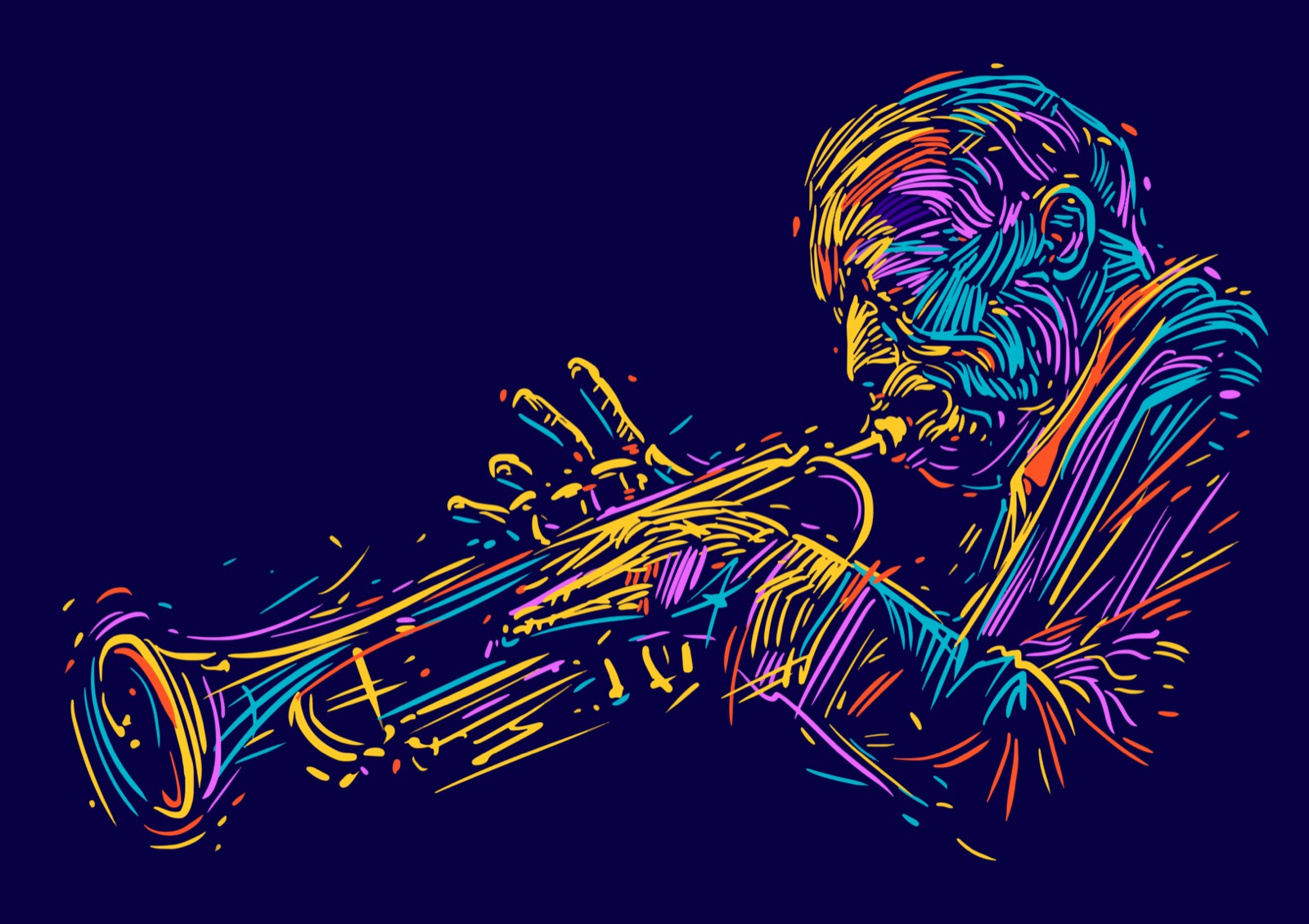Scientists Discover What Makes Jazz Music Swing
10:33 minutes

 Swing is a propulsive, groovy feeling that makes you want to move with the music. It’s hard to put into words, but if you listen to jazz, you’ve probably felt it yourself.
Swing is a propulsive, groovy feeling that makes you want to move with the music. It’s hard to put into words, but if you listen to jazz, you’ve probably felt it yourself.
Now, researchers have arrived at a better understanding of what generates that feeling: Their work, published in Communications Physics, focuses on timing differences between a group’s soloist and its rhythm section.
Joining Ira to discuss the new findings are Theo Geisel, a professor of theoretical physics at the University of Göttingen and the Max Planck Institute for Dynamics and Self Organization, and Javier Arau, a saxophonist and the founder and executive director of the New York Jazz Academy.
Invest in quality science journalism by making a donation to Science Friday.
Theo Geisel is a professor of theoretical physics at the University of Göttingen and the Max Planck Institute for Dynamics and Self Organization in Göttingen, Germany.
Javier Arau is a saxophonist and the founder and executive director of the New York Jazz Academy in New York, New York.
LOUIS ARMSTRONG: (SINGING) What is this thing called swing? What is this thing called swing? Is it jazz? It’s ragtime, futuristic ragtime. What is this thing called swing?
IRA FLATOW: Louis Armstrong’s 1930s rendition of What is This Thing Called Swing echoes a question that has mystified jazz musicians for a century. Just what is this thing called swing? Well, you might say that swing is a propulsive groovy feeling that makes you want to move with the music. It’s hard to put into words. But if you listen to jazz, you’ve probably felt it yourself.
And now scientists are trying to arrive at a more exact definition of swing. And in research published in Nature Communications Physics, they have concluded that a key ingredient may be tiny timing differences between a group soloist and its rhythm section. Downbeat delays, they say, are a key component of swing jazz. Here with an upbeat explanation of the downbeat is one of the scientists who studied jazz.
Theo Geisel, professor of theoretical physics at the University of Goettingen and the Max Planck Institute for Dynamics and Self-Organization in Goettingen, Germany. Dr. Geisel studies the physics of synchronization. His background as a jazz musician sparked an interest in how timing affects musical perception. Also joining me is Javier Arau, a saxophonist and the founder and executive director of the New York Jazz Academy based here in New York City. Theo, Javier, welcome to Science Friday.
JAVIER ARAU: Ira, thank you for having me.
THEO GEISEL: Thanks, it’s a pleasure.
IRA FLATOW: Javier, how do you define swing? Is it definable?
JAVIER ARAU: Is it definable? I think this is sort of the holy grail. And the idea of tying this into science is something that really thrills me. Swing is very enigmatic, and it’s very, very personal. So I do feel that people find swing in different ways. But I will agree, when you hear it, you know it.
IRA FLATOW: How does swing make you feel? You say when you hear it, you know it.
JAVIER ARAU: I’m going to say, swing makes me happy. It really is something, when the music is swinging, it’s something very deeply satisfying. And from there, it can become almost cathartic, I think. It’s something that– no matter if it’s Louis Armstrong or Charlie Parker or modern players, everyone is reaching the highest quality swing we can in jazz.
And swing, by the way, transcends jazz. You can find swing in all sorts of music. I mean, it’s definitely an attitude and a confidence, not just the way that the beat relates in the music.
IRA FLATOW: OK. I’m going to play two brief clips from the same song. And after hearing both of them, I want both of you to tell me which one you think swings more. Let’s hear the first clip.
[MUSIC PLAYING]
OK, now the second clip.
[MUSIC PLAYING]
Javier. What do you think?
JAVIER ARAU: Oh. OK, the pressure’s on. I’m going to put in– I’m going to put in my vote for number two.
IRA FLATOW: Why is that?
JAVIER ARAU: Goodness. So, look, I’m coming at this not from a science angle, just as a saxophonist. And I felt like number two, the downbeats really connected a bit more strongly. I felt like there was more– you mentioned propulsion at the beginning. I think that’s a great word. I would also say the right propulsion can lead to more momentum.
And momentum is one of the things that makes jazz, to me, really, really thrilling. So I sensed the second one, the pianist’s down beats were a little more connected to where the bassist and drummer were connecting. Now, just so I’m understanding, the bass and drums, it sounded like perhaps that was a computer recording, or like a MIDI performance, and then the pianist was live? Is that–
THEO GEISEL: That’s true.
JAVIER ARAU: Is that what I was hearing, or– yeah.
IRA FLATOW: Yes, Theo– because these are actually clips, Theo, that you used in your research, right?
THEO GEISEL: Yes.
IRA FLATOW: What’s the difference between them? Give us the answer.
THEO GEISEL: We manipulated the timing in MIDI recordings, in various ways, and had professional and semi-professional jazz musicians rate how much swinging these different manipulations– these different recordings were. In the recording you just played, we had one version without any delays, one version where only the downbeat were delayed– the off beats were synchronized with the rhythm section.
IRA FLATOW: Delaying the downbeats. What did that do? Did that enhance the swing feel?
THEO GEISEL: Yes. Well, that’s what we found. First I should say, there are, of course, several ingredients– several components– that contribute to swing. And the most obvious one that everybody can hear is the so-called swing ratio, or it’s the ratio between downbeats and off beats. Some people even believe that this is swing, and that’s all. But jazz musicians know that this is not the case. There is more to it, as Javier just explained.
IRA FLATOW: And you found that delaying the downbeat– I’m reading from your paper– made it seven and a half times more likely that a jazz musician would rate the recording as swinging, right?
THEO GEISEL: That’s it, exactly. But only delaying the downbeats. If we delayed both downbeats and off beats, then it doesn’t make a difference. It doesn’t increase, or enhance, the swing feel.
IRA FLATOW: How do you– how do you react to that, Javier? Do you notice yourself doing this when you play?
JAVIER ARAU: You know, anecdotally, I think back to when I was first learning jazz. You know, I’m thinking back when I was 13, 14 years old. I was a very excited player, and I had so many mentors who would hear me play and say, Javier. You got to just calm down. You got to relax when you play. And so, you know, I’m hearing this and it makes perfect sense to me because I do feel as jazz musicians, we’re maintaining a certain awareness that’s very high.
Yet, at the same time, we really have to approach the music in a really relaxed state. That’s hard to achieve, because so much in music performance takes a critical ear, very quick thinking. I think a next step, reasonably, is to include, say, a live bassist to play that walking bass line, to play those down beats. Because ultimately, the beat is alive. It’s a very human element. And just the way two musicians interact, maybe that is the next step. I’m curious what happens after these studies.
THEO GEISEL: I fully agree. It would be worthwhile having several musicians play simultaneously. But that’s very difficult, because the bass has so low frequencies. It is much more difficult to determine the tone onsets of the base.
IRA FLATOW: What about vocalists? Do they do the same thing?
THEO GEISEL: Well, we could do that. But as I said, it’s much more complicated determining the tone onsets with vocalists, and especially with bass. It’s much more complicated. It’s very tedious, and not as accurate.
JAVIER ARAU: Yeah, I can imagine. Because piano, it’s essentially a percussion instrument. So you have, in MIDI terms, key on, key off. You can measure that. But if you– if I think about any vocalists, there are aspirations, there’s diction. What is the actual note? When does it start? It’s the same thing for us on saxophone. How do we know exactly where that beat starts? It’s hard to say.
IRA FLATOW: Javier, do these new findings change how you might teach jazz to your students?
JAVIER ARAU: What I love is that it’s quantified a bit, and that’s always helpful, I think, in teaching to be able to point students in the direction of this scientific research. And I think it’s fortunate that it does support what jazz musicians have been saying for a long time. I mean, I’ve never met a jazz musician who says, oh, no, no, no, no, play ahead of the beat. That’s not something that’s really common. And this goes back for decades and decades.
IRA FLATOW: Gentlemen, I have run out of time. I want to thank both of you, Theo and Javier, for taking time to talk with us today. Excellent discussion.
JAVIER ARAU: Well, it’s been such a pleasure. Thank you for having us, Ira.
THEO GEISEL: Well, it was a pleasure for me, too.
IRA FLATOW: Theo Geisel, professor of theoretical physics at the University of Goettingen and the Max Planck Institute for Dynamics and Self-Organization in Goettingen, Germany. Javier Arau, a saxophonist and the founder and executive director of the New York Jazz Academy based in New York City.
LOUIS ARMSTRONG: (SINGING) It don’t mean a thing if it ain’t got that swing.
Copyright © 2022 Science Friday Initiative. All rights reserved. Science Friday transcripts are produced on a tight deadline by 3Play Media. Fidelity to the original aired/published audio or video file might vary, and text might be updated or amended in the future. For the authoritative record of Science Friday’s programming, please visit the original aired/published recording. For terms of use and more information, visit our policies pages at http://www.sciencefriday.com/about/policies/.
As Science Friday’s director and senior producer, Charles Bergquist channels the chaos of a live production studio into something sounding like a radio program. Favorite topics include planetary sciences, chemistry, materials, and shiny things with blinking lights.
Jason P. Dinh is Climate Editor at Atmos Magazine in Washington, DC. He previously was an NSF-funded intern at Science Friday.
Ira Flatow is the founder and host of Science Friday. His green thumb has revived many an office plant at death’s door.